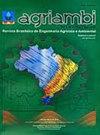Salinity and flow rates of nutrient solution on cauliflower biometrics in NFT hydroponic system
IF 1.4
4区 农林科学
Q3 AGRICULTURAL ENGINEERING
Revista Brasileira de Engenharia Agricola e Ambiental
Pub Date : 2020-04-01
DOI:10.1590/1807-1929/agriambi.v24n4p258-265
引用次数: 11
Abstract
The use of brackish water in hydroponic crops represents an alternative for vegetable production. In this context, two experiments were conducted to evaluate the effect of using brackish water to prepare the nutrient solution and replace the evapotranspired depth, applied at different flow rates, on cauliflower biometrics in NFT (nutrient film technique) hydroponic system. In both experiments, the experimental design was completely randomized with four repetitions, in a 6 x 2 factorial scheme: six levels of water electrical conductivity (ECw) in interaction with two flow rates of nutrient solution application in the hydroponic channels (1.5 and 2.5 L min-1). In Experiment I, brackish waters with different EC (1.5, 2.5, 3.5, 4.5 and 5.5 dS m-1), obtained by the addition of NaCl in public-supply water (0.2 dS m-1), were used. In Experiment II, the chemical characteristics of brackish waters collected in the semiarid region of Pernambuco were simulated, with EC of 1.67, 3.30, 4.71, 5.88 and 13.84 dS m-1, plus the control (0.2 dS m-1). Increasing salinity reduced cauliflower growth. Flow rate of 1.5 L min-1 promoted the best results of shoot fresh and dry masses, leaf area, number of leaves, plant height and shoot diameter. The best water for cauliflower production was publicsupply water and, among the well waters, the best was the calcium sulfate-rich water with EC of 1.67 dS m-1.NFT水培系统中营养液盐度和流速对菜花生物特征的影响
在水培作物中使用微咸水是蔬菜生产的另一种选择。在此背景下,进行了两个实验,以不同的流速,用微咸水制备营养液和替代蒸发蒸腾深度,对NFT(营养膜技术)水培系统中花椰菜生物特征的影响进行了评价。在这两个试验中,试验设计完全随机,重复4次,采用6 × 2因子方案:6个水平的水电导率(ECw)与水培通道中两种营养液流速(1.5和2.5 L min-1)的相互作用。实验一采用在公共供水(0.2 dS m-1)中加入NaCl得到的不同EC值(1.5、2.5、3.5、4.5和5.5 dS m-1)的微咸水。实验二模拟了半干旱区伯南布哥半干旱区微咸水的化学特性,EC分别为1.67、3.30、4.71、5.88和13.84 dS m-1,外加对照(0.2 dS m-1)。盐度增加降低了花椰菜的生长。流量为1.5 L min-1时,茎部鲜质量、干质量、叶面积、叶数、株高和茎粗效果最佳。生产花椰菜的最佳用水为公共供水,井水中以富硫酸钙水为最佳,其EC值为1.67 dS -1。
本文章由计算机程序翻译,如有差异,请以英文原文为准。
求助全文
约1分钟内获得全文
求助全文
来源期刊

Revista Brasileira de Engenharia Agricola e Ambiental
Agricultural and Biological Sciences-Agronomy and Crop Science
CiteScore
2.70
自引率
16.70%
发文量
114
审稿时长
3-8 weeks
期刊介绍:
A Revista Brasileira de Engenharia Agrícola e Ambiental (Agriambi), periódico oficial da Asociación Latinoamericana y del Caribe de Ingeniería Agrícola (ALIA), é editada mensalmente, no formato eletrônico, pela Unidade Acadêmica de Engenharia Agrícola (UAEA) do Centro de Tecnologia e Recursos Naturais (CTRN) da Universidade Federal de Campina Grande (UFCG), destinando-se à divulgação de artigos científicos originais e inéditos, elaborados em Português, Inglês ou Espanhol. Com o auxílio de pareceres de Consultores, os artigos são aceitos ou não pela Equipe Editorial para publicação na Revista. A Agriambi aceita, também, a submissão de contribuições na modalidade de revisão de literatura.
 求助内容:
求助内容: 应助结果提醒方式:
应助结果提醒方式:


